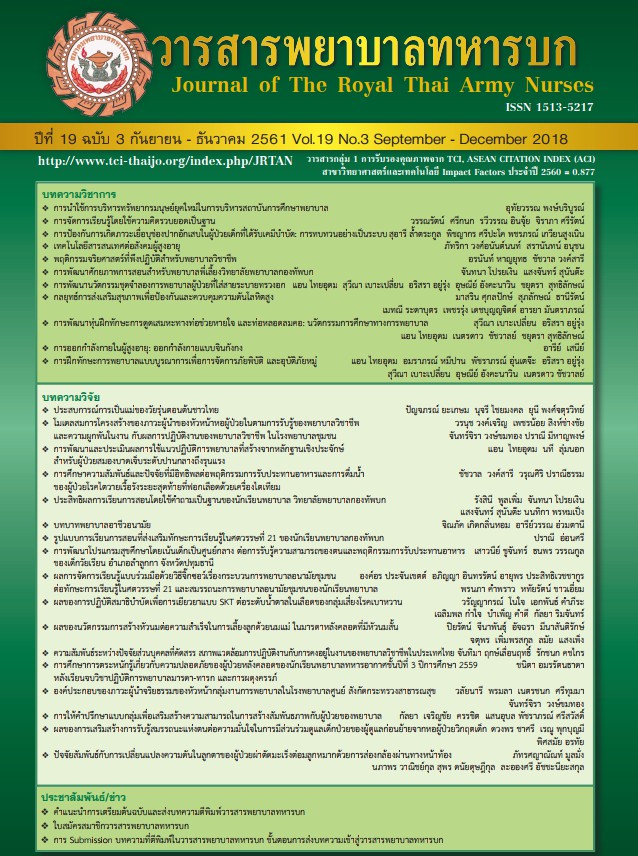Effects of the Making Nipple Innovation To the Successful of Breastfeeding in postpartum mothers with Short Nipples
Keywords:
the making nipple innovation, postpartum mothers, short nipplesAbstract
Postpartum mother with short nipple have a breast feeding problem; infant can’t suck for milk or sucking not quite well. The purpose of this study was to examine the effects of the Making Nipple innovation to the successful of breastfeeding in postpartum mothers with short nipples. This quasi experimental research study with one group 3 repeated measure design. 28 subjects were selected with purposive sampling technique from postpartum mothers whose nipple length less than 7 mm at Maharaj Nakhon Si Thammarat hospital. This study was conducted between May to October 2016. Research instruments included the Making Nipple innovation at the breastfeeding clinic, questionnaires on latch on assessment tool (LATCH score) and pain assessment form. The data were analyzed using frequency, percentage, mean, standard deviation, and one-way repeated measure ANOVA. The results reveal that, in the first visit period, during using innovation the first visit period, before discharge period, and 7 days postpartum period. The LATCH score were increased ( = 2.92, 7.10, 9.00, 10.00 respectively), the pain score were decreased ( = 4.50, 1.67, 0.39, 0.00 respectively), and the nipple length were increased. Left side = 0.33, 0.95, 0.79, 0.82 respectively, right side = 0.35, 0.95, 0.80, 0.81 respectively. In addition, the result of comparisons shows; the LATCH score, and nipple length after using innovation in all period as during using innovation the first visit period, before discharge period, and 7 days postpartum period were significantly higher than before using innovation, and the pain score after using innovation in all period were significantly lower than before using innovation at the level of .05. Using the Making Nipple innovation were effected to successful of breastfeeding in postpartum mothers with short nipples
Downloads
References
2. World Health Organization. Guideline: protecting, promoting and supporting breastfeeding in facilities providing maternity and newborn services. Geneva : WHO Document Production Service; 2017
3. Siriwanarangsun P. The role of the Ministry of Public Health in promoting breastfeeding. The 5th national breastfeeding conference proceeding on September, 2-4, 2015, Montean riverside hotel, Bangkok. Bangkok: Print and More Ltd. 2015. 30-3 (in Thai)
4. National Statistical Office. Situation survey of children and women in 2012, in Thailand. Bangkok : National Statistical Office; 2013. (in Thai)
5. Bureau of Health Promotion, Department of health, Ministry of Public Health. Manual for Breastfeeding specialist training. 2nd edition. Bangkok: Veterans Administration Organization; 2010. (in Thai)
6. Vichitsukon K., Saengperm P., Wathayu N., Reunjiratthian S., Payakkaraung, S. editor. Breastfeeding. Bangkok: Prewan Ltd.; 2012 (in Thai)
7. Tangsuksan P. Breastfeeding Promotion in Pregnant women. Journal of Public Health Nursing 2011; 25(3) :103-19 (in Thai)
8. Chanprapaph P. Outcome of Non-protractile nipple collection with breast cups in pregnant women: a randomized control trial. the 4th national breastfeeding conference proceeding, June, 5-7, 2013, Miracle Grand hotel, Bangkok. Bangkok: print and more Ltd. 2013;143 (in Thai)
9. Baiya, N. Ketsuwan, S. Thana, S. Puapornpong P. Outcome of nipple puller use in short nipple pregnant women. the 5th national breastfeeding conference proceeding, September, 2-4, 2015, Montean riverside hotel, Bangkok. Bangkok: print and more Ltd. 2015;150 (in Thai)
10. Puapornpong P, Aimjirakul K., Chomto S., Domrongrongsiri O. editor. Clinical practice of breast feeding. Bangkok: Beyond enterprise. 2016. (in Thai)
11. Puapornpong P. Breastfeeding assessment. Journal of Medicine and Health Sciences 2014;21(1).:4-15 (in Thai)
12. Srijaroenwanit C., Jiraphaet V. Lived experience of breastfeeding mothers with breast-refusal infants. Journal of The Royal Thai Army Nurses 2018; 19 (supplement):155-66 (in Thai)
13. Darmangeat, V. The frequency and resolution of nipple pain when latch is improved in a private practice. Clinical lactation. 2011;2(3):22–4
14. Sangpeng L., Tongsam J., Kanjanahirun P. The effects of using teaching program to for breastfeeding. Research paper. Nakon Si Thammarat hospital. 2011. (in Thai)
15. Wongphinit U., Sinsuksai, N. Yusamran C. Personal factors, social support and effective suckling at discharge in predicting exclusive breastfeeding at one month among first-time mothers. Journal of The Royal Thai Army Nurses 2016;17(1):88-95 (in Thai)
16. Indraccolo U., Bracalente M., Iorio R. D., Indraccolo S.R. Pain and Breastfeeding: a prospective observational study. Clinical and experimental obstetrics and gynecology an international journal. 2012; 39(4): 454-7
17. Kent J.C.,et al. Nipple pain in breastfeeding mothers: Incidence, causes and treatments. International journal of environmental research and public health. 2015;12(10): 12247-63
18. Jaingam, S., jitraorn, S., Anuntariyakul C. The effectiveness of nipple plaster to solve short nipple problem in postpartum woman at Phaholpolpayuhasena Hospital. Kanchanaburi : Phaholpolpayuhasena Hospital; 2011 (in Thai)
Downloads
Published
How to Cite
Issue
Section
License
บทความหรือข้อคิดเห็นใดใดที่ปรากฏในวารสารพยาบาลทหารบกเป็นวรรณกรรมของผู้เขียน ซึ่งบรรณาธิการหรือสมาคมพยาบาลทหารบก ไม่จำเป็นต้องเห็นด้วย
บทความที่ได้รับการตีพิมพ์เป็นลิขสิทธิ์ของวารสารพยาบาลทหารบก
The ideas and opinions expressed in the Journal of The Royal Thai Army Nurses are those of the authors and not necessarily those
of the editor or Royal Thai Army Nurses Association.






